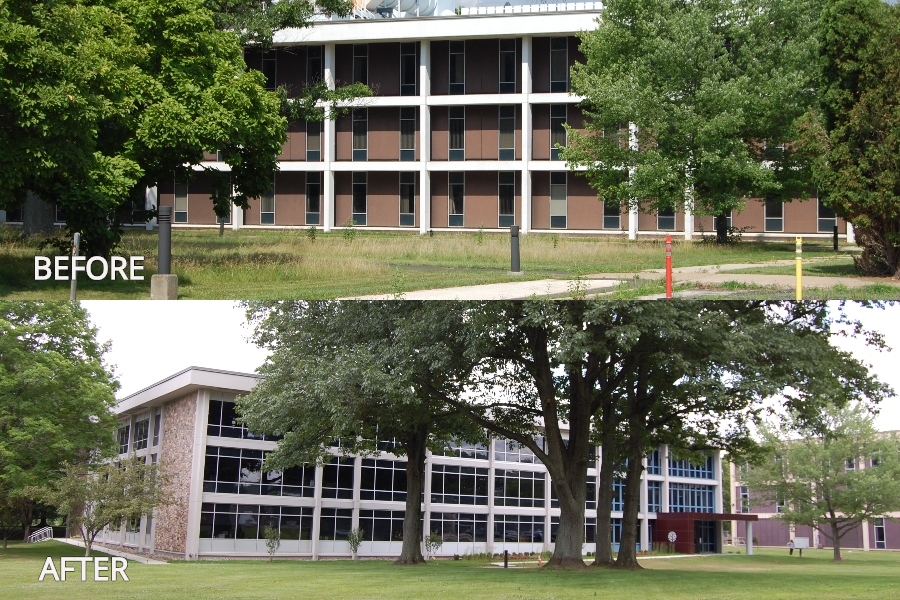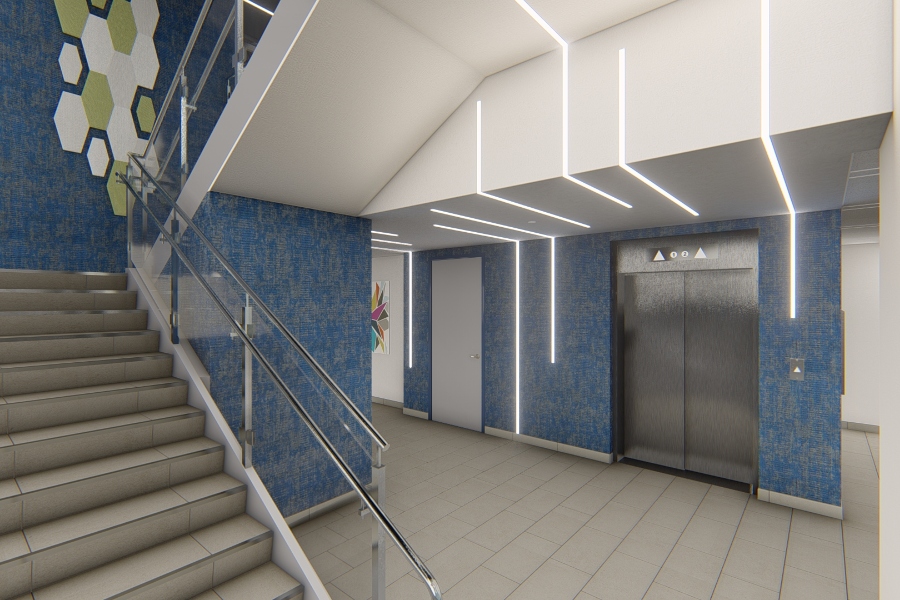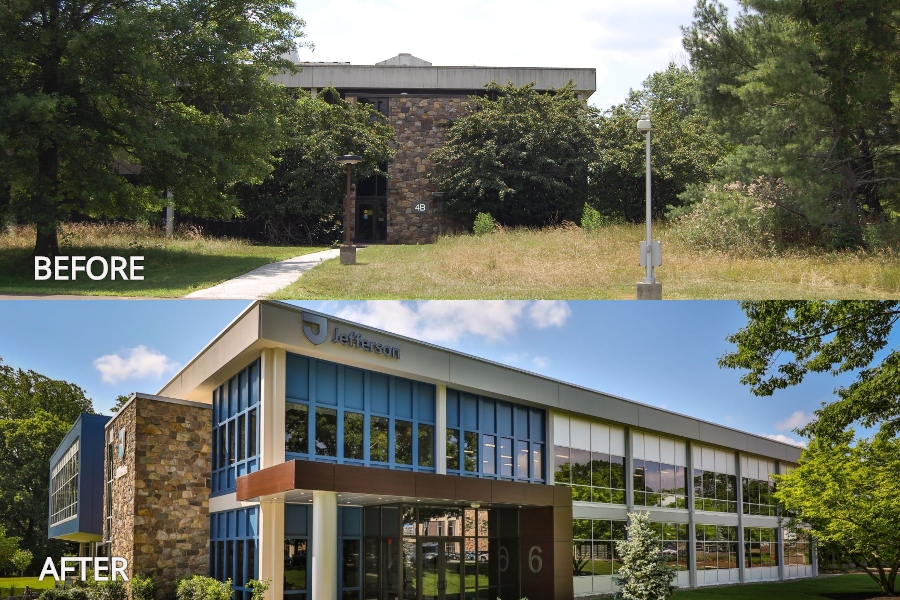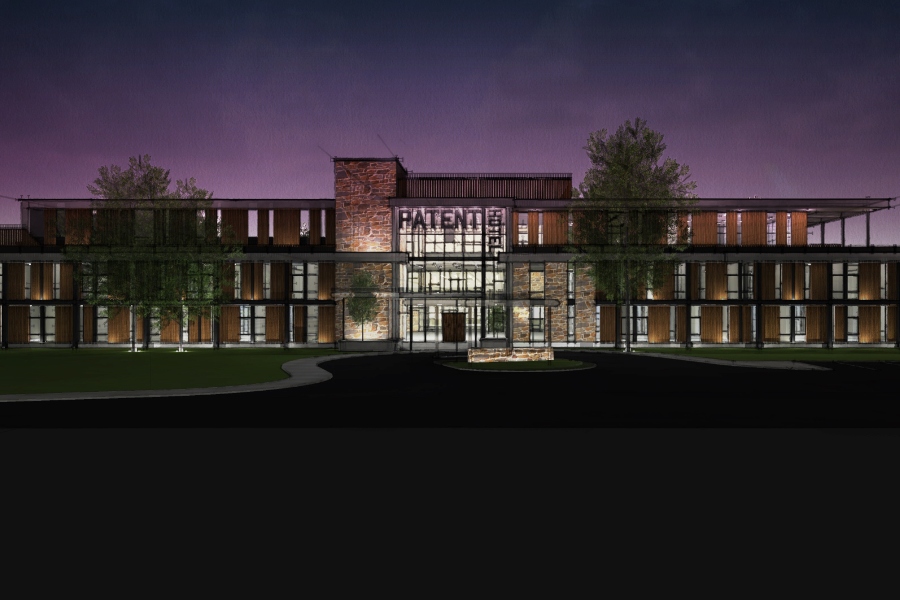Biotech Tour: Inside the Newly Rehabbed Spring House Innovation Park
With a $100 million investment, MRA Group hopes to turn the 1960’s-era suburban research campus into an energy-efficient innovation hub.

An aerial view of Spring House Innovation Park at 727 Norristown Rd. / Courtesy of MRA Group
Lower Gwynedd Township in Montgomery County is now home to a new innovation hub born of old bones. Spring House Innovation Park (SHIP), a 600,000-square-foot business and research campus, sits on more than 133 acres of land that are being revitalized by real estate development firm MRA Group in the former R&D facility of chemical manufacturer Rohm and Haas.
The developers assumed a massive undertaking when they purchased the then-vacant campus back in 2017. They’ve since spent nearly $50 million, roughly half of what they have earmarked for the project, bringing the dated and poorly maintained campus up to modern standards. More than half of MRA Group’s planned renovations for the site are complete; the rest, including a host of attractive amenities, is currently under construction. But that hasn’t stopped companies from claiming their place on the campus. In October 2019, international cancer diagnostics biotechnology firm AnPac Bio leased a 6,724-square-foot space to establish its U.S. corporate headquarters and the company’s first clinical lab site on the east coast.
In addition to providing move-in ready office and lab space just 12 miles from Philadelphia, the site boasts trickle-down savings as a result of MRA Group’s focus on incorporating state-of-the-art energy-efficient equipment throughout the campus.
NextHealth PHL recently toured the space with MRA Group president and chief executive officer Lawrence Stuardi, senior vice president Mike Wojewodka, facility engineering vice president Hank Merrill, and strategic partnerships vice president Phillip Butler.
Here are some of the most drastic changes I saw on the tour and a preview of what’s still to come in the campus transformation:
The Bones

MRA Group vice president of facility engineering, Hank Merrill shows off old and new boiler systems in SHIP’s Central Utility Plant. / Courtesy of MRA Group
When Rohm and Haas constructed its research and development campus in 1963, it was state-of-the-art for its time. But after more than 40 years of operating with minimal modern updates and several years unattended, the site needed a major overhaul by 2017. There were hot water boilers (now considered archaic compared to their modern condensing steam boiler counterparts), decades-old compressed air and steam systems and miles of underground piping that had leaks and water degradation.
MRA Group invested $5.8 million to replace the site’s 1960-era central utility plant with a high-efficiency chilled and hot water production plant, including variable speed air compressors. The plant was designed to support labs in at least three of the 14 buildings on the campus. Additional equipment upgrades throughout the campus have led to lower energy bills which, in turn, translate to more affordable leasing rates for tenants.
“We put in new chillers, condensing boilers, new towers and air compressors to support the lab buildings,” Merrill said. “From an energy standpoint, the results have been dramatic. We’ve had great success in driving the costs down.”
The site boasts an impressive list of energy-efficient features, including:
- A ductless HVAC system that uses variable refrigerant flow to exchange and deliver heat between rooms, reducing HVAC energy costs by as much as 30 percent. SHIP’s heating bill has averaged around $300 per month to heat up to 70,000 square feet of space at 84 percent occupancy.
- Variable frequency drives that enable site managers to adjust the energy output of motors, pumps, fans and more to avoid running the equipment at its highest output at all times. SHIP’s electricity costs are 50 percent lower while in operation than they were in 2016 when the campus was vacant and running its older energy systems.
- LED light fixtures throughout the campus that turn on instantaneously, have a longer life span, are dimmable and have occupancy sensors that “wake up” to full illumination if a person is detected.
- Nine Tesla charging stations will be installed in three locations on SHIP’s campus this year. The amenity will be open for tenants and members of the community to use free of charge.
“Going into it, we knew the system would cost several thousand dollars more, but we also knew the tenants would benefit from it,” Stuardi said. “Everyone talks about being green and they go for all the things that are most obvious to people, but this is a step beyond. It’s an amazing system and we’re seeing how it brings costs down. It’s an operating expense that we get to pass down to the tenants in savings.”
The Buildings

A before and after image of building eight at Spring House Innovation Park. / Courtesy of MRA Group
SHIP’s campus has a total of 14 buildings that, like the site’s infrastructure, were in a state of considerable disrepair before MRA Group took ownership of the property. Some buildings have been renovated, while others are being demolished to be completely rebuilt. Ongoing construction has not stopped a steady stream of tenants from moving in.

Renovated buildings at SHIP boast modern features like strip lighting and colorful decor. / Courtesy of MRA Group
Oriental Yuhong, Asia’s largest waterproofing system provider, was the first tenant to move into a space at SHIP in August 2017, just a few months after MRA Group closed the sale on the property. The company leased 19,000 square feet to establish a research and development center.
Clinical research service organization Clinlogix moved to SHIP in April 2018, followed by AgroFresh, a former division of Dow that relocated from Collegeville to be closer to the city.
Evertree Technologies, a maker of plant-based chemicals, recently came from Paris, France to establish an innovation center on SHIP’s campus.
Other companies like Cognizance Biomarkers, ChromaTan and Evol Science have migrated to the suburban campus from University City. And in May 2019, Thomas Jefferson University claimed a 25,000-square-foot space for its new bioprocessing institute.

In May 2019, Thomas Jefferson University claimed a 25,000 square foot space on SHIP’s campus for its new bioprocessing institute / Courtesy of MRA Group
The developers say they’ve been able to attract diverse companies of all sizes to SHIP’s many move-in ready spaces because they eliminate the need to wait for new construction.
“Speed to market is a big factor in attracting tenants,” Wojewodka said. “We have a good mix of tenants. Our smallest tenant is in a 700-square-foot space and our largest is in 50,000 feet. It’s truly a place where companies can grow from concept to commercialization.”
The Amenities

This summer, MRA Group plans to add a branded, 100-room hotel. / Courtesy of MRA Group
SHIP already has a host of impressive amenities. The campus is open but it’s not so vast that it becomes un-walkable. New landscaping and a 1.2-mile paved loop around the campus makes it easy for tenants to move between buildings or take long walks throughout the workday.
SHIP also boasts an inviting central courtyard that functions much like a quad on a college campus. The developers have already begun planning movie screenings and other social events in the courtyard, where tenants and community members can come to lounge around a modern fire pit or spread out blankets on the open lawn.
MRA Group has even more additions in the works. By the end of the summer, developers expect to unveil:
- An additional 70,000 square feet of lab space
- A branded 100-room hotel, to be aptly named The Patent in homage to the many current and former tenants who’ve patented inventions made on the campus
- A reconstructed building that will house a co-working space and a conference center large enough to host meetings for up to 250 people
- A coffee shop, a brewery, and a restaurant with a rooftop bar
- An outdoor fitness center that will allow tenants and community members to download and practice workout routines using an app

A fitness court, opening in April at SHIP was supported by a grant to Lower Gwynedd township from the National Fitness Alliance. / Courtesy of MRA Group
“Our goal is to create an environment that people want to grow in,” Stuardi said. “We see this as a community asset. Long after we’re gone, it’s important to us that we leave something behind that will be beneficial to the community. It sounds like a great idea but it’s tougher to do.”
With that future in mind, MRA Group says they’re considering using undeveloped land on the campus to build a new retail center and townhouse development, additions that will benefit the broader community for the foreseeable future.
“There are plenty of spaces, but there aren’t many environments like this one,” Stuardi said. “The community knows they are welcome to use our campus. People want their companies here because they want their employees to have access to more than just a box to work in for nine hours. Our tenants engage with the community and give back to it. We also feel an equal obligation to give back to the community; this campus allows us to do that.”


